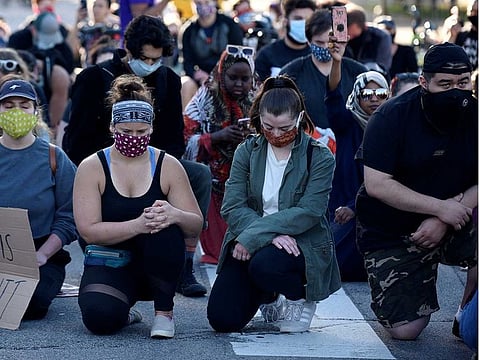America’s cycle of police brutality sparks major unrest
Protests continue unabated in Minneapolis over death of an unarmed black man in custody

Americans have been outraged by video of the death of George Floyd, a 46-year-old African American man at the hands of Minneapolis police officers on Monday. Floyd died soon after an officer knelt on his neck for several minutes as he visibly struggled for breath and cried out for help. The video of the violent encounter resulted in the firing of four Minneapolis police officers. The city’s mayor, Jacob Frey, stated, “Being black in America should not be a death sentence.”
But protests erupted just 24 hours after Floyd’s death, with demonstrators calling for structural change, recognising this as the latest in a long history of black people killed at the hands of the police, chanting, “No justice, no peace” and “I can’t breathe.” Activists criticised the mayor for increasing funds to the Minneapolis Police Department: They demanded cuts to the department’s budget and reinvestment in community infrastructure.
Such protests have become common in a country where more than 1,000 people annually are killed by police, with black people three times as likely as whites to be the victims. Also common is what happened soon after demonstrators gathered to protest Floyd’s death: Police in riot gear shot tear gas canisters into the crowds and fired stun grenades and “nonlethal projectiles” at demonstrators, injuring many. It was stunningly easy to point to the same department’s gentle treatment weeks ago against white anti-lockdown protesters while those protesting against police violence were met with militarised violence.
Reducing the capacity for police to engage in routine and militaristic violence is the only way to break recurring cycles of police killings and the militarised response that protests of them are often met with.Philip McHarris, American civil rights activist
But this too should not surprise us. Police departments have come to resemble military units, contributing to deadly violence disproportionately against black Americans. While many policies related to policing and mass incarceration happen at the local level, the militarisation of police has been promulgated by federal policies.
Militarised policing dates to the 1960s. The acquisition of military-grade gear by local police departments began under Lyndon Johnson’s War on Crime. The 1965 Law Enforcement Assistance Act (LEAA) established a federal funding stream to increase the strength and size of local law enforcement. The federal stream also provided police departments with funding for military-grade equipment. In 1968, Congress passed the Omnibus Crime Control and Safe Streets Act making this funding stream permanent.
In recent years local police departments got newly available gear and many amassed stockpiles of equipment. SWAT teams, deployed raids and other police activities where military-grade equipment was utilised exploded across the country — creating droves of militarised police that increasingly looked like soldiers. As police departments acquired billions of dollars of military-grade equipment, there was no required training. Even worse, departments had to use what they acquired at least once within one year of receiving them — a clause that incentivised using unnecessary force and surveillance.
Movement for Black Lives against police violence
After a white police officer killed Michael Brown in Ferguson, Missouri, on Aug. 9, 2014, local residents organised months of sustained protest against the killing, sparking a national Movement for Black Lives against police violence. During the months of activism in Ferguson, images of armoured police vehicles and clouds of tear gas used to quell mostly black protesters shocked the nation. Across the country many wondered how local police got their hands on military-grade equipment.
The pushback led then-President Barack Obama to research and release a 2014 Executive Office report on how federal programs had supplied police departments with military equipment. He issued Executive Order 13688, placing restrictions on the federal transfer and funding of military equipment for local police that blocked the inclusion of gear such as tracked armoured vehicles, rifles with bayonets, battering rams, riot gear and explosives. The executive order also required more training and stricter documentation requirements around the use of the gear.
But, President Donald Trump reversed Obama’s restrictions and fully restored the program Obama had cut. Then-Attorney General Jeff Sessions said to the Federal Order of Police in Nashville, Tennessee. “Those restrictions went too far ... We will not put superficial concerns above public safety.” The Trump administration has allowed equipment to flow freely and intensified concerns around the danger that militarised police forces bring.
Researchers in recent years have shown that places with more military gear have increased police killings. Today military gear is used to execute routine warrants and raids. The war on drugs era also produced laws paving the way for no-knock and quick-knock warrants, making way for scores of botched raids. More than 40,000 raids are done each year across the country — disproportionately in black and Latinx communities, overwhelmingly for the execution of drug warrants — and often leading to tragic, unnecessary injuries and fatalities — including the recent killing of Breonna Taylor.
The cycle of police brutality sparking unrest, and that unrest being met by the militarised police is increasingly familiar in modern American society. Tough-on-crime policies and militarised police departments have paved the way for increased police contact and tragic violence. Reducing the capacity for police to engage in routine and militaristic violence is the only way to break recurring cycles of police killings and the militarised response that protests of them are often met with.
— Philip McHarris is an American civil rights activist, political writer and academic at Yale University.
Sign up for the Daily Briefing
Get the latest news and updates straight to your inbox







